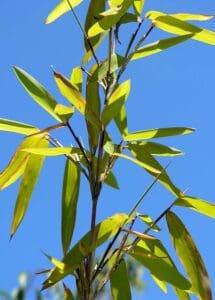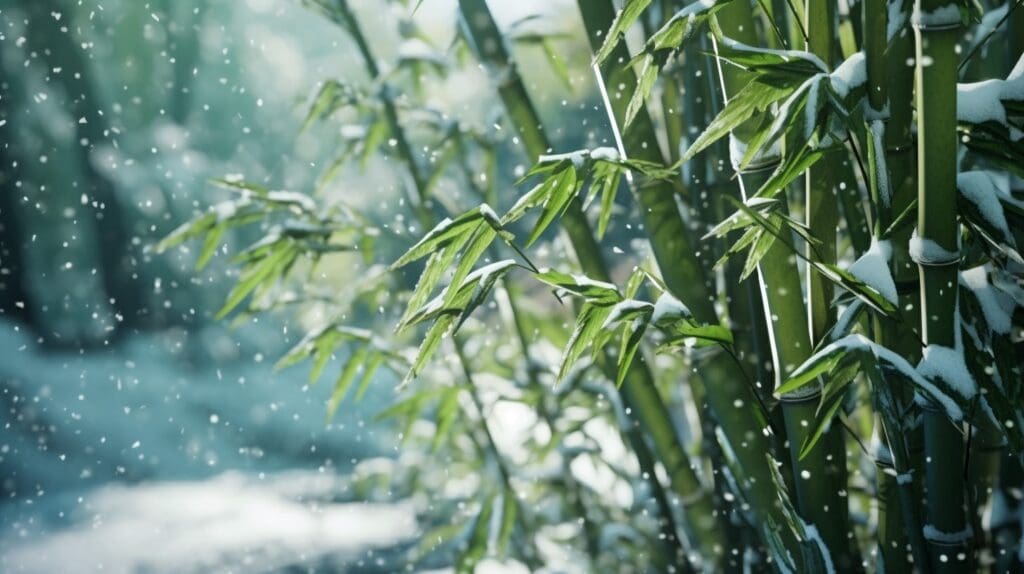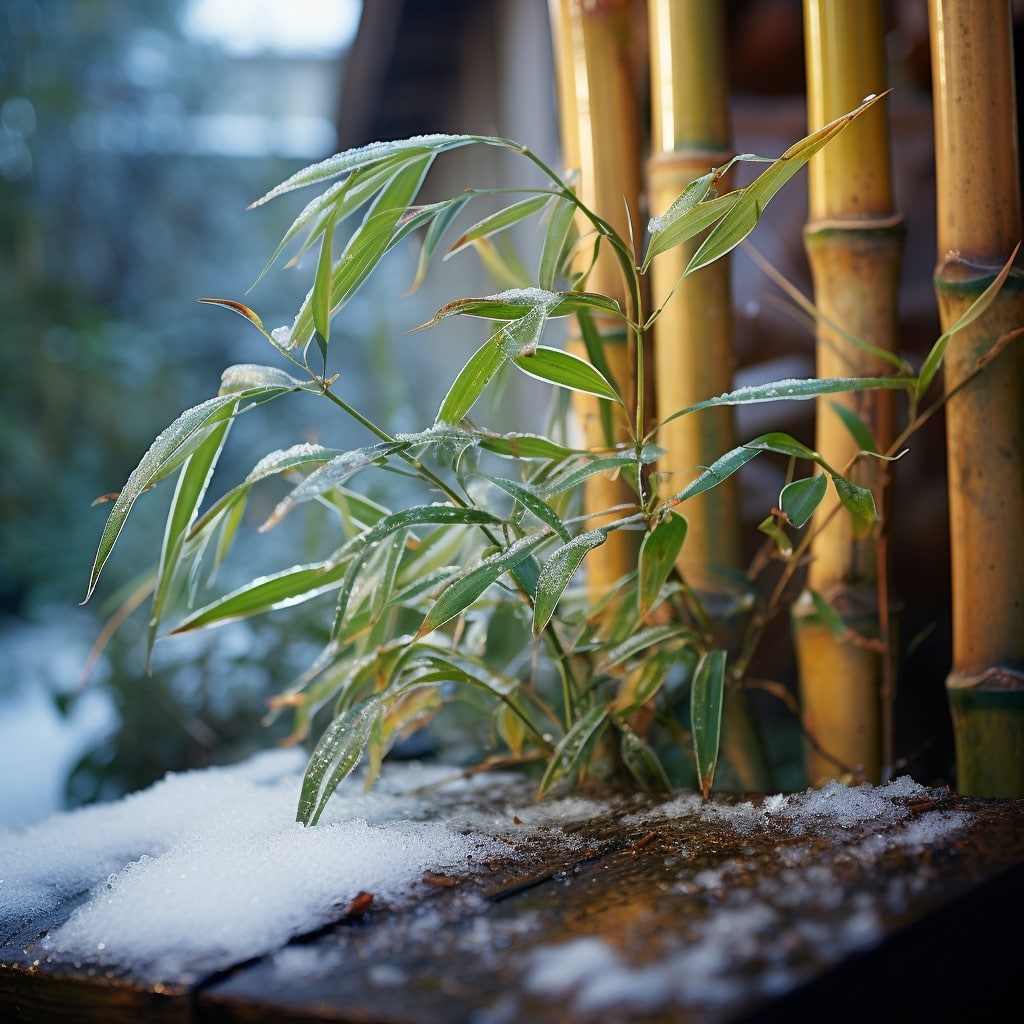Are you wondering if it’s possible to grow bamboo in Alaska? The answer is yes, but it requires careful planning and consideration. Bamboo is typically associated with warm, tropical climates, but there are many cold-tolerant species that can thrive in colder regions like Alaska.
Choosing the right variety of bamboo for your Alaskan climate is crucial for successful growth. It’s important to understand the soil and water requirements needed for your specific bamboo species, as well as how to protect them from harsh Alaskan winters.
With proper care and maintenance, growing bamboo in Alaska can be a rewarding experience. In this article, we’ll explore the different types of cold-tolerant bamboo species suitable for Alaskan climates and provide tips on how to successfully cultivate and maintain them.
Cold-Tolerant Bamboo Species
You can definitely try growing bamboo in Alaska with cold-tolerant species that can withstand the chilly climate! There are several species of bamboo that can thrive in lower temperatures, such as Phyllostachys nigra, Fargesia nitida, and Semiarundinaria fastuosa. However, it’s important to note that some maintenance and care will be required to ensure their survival.
Alaska’s climate zones can be broadly categorized into three main types: coastal, transitional, and continental. Each of these zones presents unique challenges and opportunities for plant growth.
The coastal zone, influenced by the Pacific Ocean, has milder winters and cooler summers. This zone generally falls within USDA Hardiness Zones 7 to 8, and the growing season is relatively long but cool. It’s suitable for plants that can tolerate high humidity and salt spray. There are many bamboo species suited to this climate.
The transitional zone experiences a mix of maritime and continental climates. Winters can be harsh, but summers are warmer than the coastal zone. This zone typically corresponds to USDA Hardiness Zones 4 to 6. It can support a variety of plants, but selection should be based on tolerance to temperature fluctuations. There are some varieties of bamboo that can tolerate this climate.
The continental zone, far from the moderating influence of the ocean, experiences harsh winters and hot summers. This zone generally falls within USDA Hardiness Zones 1 to 3. The growing season is short, and plants must be able to withstand extreme cold. Bamboo is not suited to this extreme climate.
Please note that these are general estimates, and the actual hardiness zone can vary based on local conditions. The U.S. Department of Agriculture (USDA) provides a Plant Hardiness Zone Map that gardeners and growers can use to determine which plants are most likely to thrive at a location. The map is based on the average annual minimum winter temperature, divided into 10-degree F zones.

Indoor cultivation is a great option for growing bamboo in Alaska and opens you up to growing bamboo species that would struggle to survive outdoors. You can use large planters or containers to grow your bamboo indoors, making sure they receive enough sunlight and water.
Bamboo can also make an excellent addition to landscaping ideas in Alaska. They add a unique touch of texture and height to any garden or landscape design. Careful planning is necessary when incorporating bamboo into landscaping projects as some species spread aggressively. However, with proper containment techniques like using root barriers, you can enjoy the beauty of this versatile plant without worrying about its potential invasiveness.
Choosing the Right Variety for Alaska
When picking out which type of bamboo will thrive in Alaska, it’s important to consider its hardiness and ability to survive harsh winters. Some bamboo species that grow well in the north are Phyllostachys nuda, Phyllostachys bissetii, and Fargesia nitida. These varieties can withstand temperatures as low as -20°F. Some other species that may be suitable for growing in some parts of Alaska are set out in the below table.



(Stan Shebs, CC BY-SA 3.0, via Wikimedia Commons)
| Scientific Name | Common Name | Description | USDA Hardiness Zones |
| Fargesia robusta | Sunset Glow Bamboo | A clumping bamboo with vibrant red culms and lush green foliage. | Zones 5-9 |
| Fargesia nitida | Fountain Bamboo | A non-invasive bamboo that forms dense clumps with arching branches and slender leaves. | Zones 5-8 |
| Fargesia murielae | Umbrella Bamboo | A cold-hardy bamboo with slender green culms and delicate foliage that creates an umbrella-like canopy. | Zones 5-9 |
| Fargesia spathacea | Spathacea Bamboo | A compact bamboo with graceful arching canes and narrow, deep green leaves. | Zones 6-9 |
| Fargesia rufa | Clumping Bamboo | A bamboo variety with orange-red culms that turn yellow-green over time and feathery foliage. | Zones 5-9 |
| Thamnocalamus spathiflorus | Spreading Bamboo | A clumping bamboo known for its gracefully arching culms and narrow, lance-shaped leaves. | Zones 7-10 |
| Himalayacalamus falconeri | Falconer Bamboo | A clumping bamboo with thick culms that emerge green and turn a golden yellow color with age. | Zones 7-10 |
| Yushania anceps | Ancep Bamboo | A clumping bamboo species featuring thick-walled culms that are initially green and later turn yellow-brown. | Zones 7-10 |
| Yushania boliana | Boliana Bamboo | A tall and upright clumping bamboo with green culms and delicate, narrow leaves. | Zones 7-10 |
| Yushania maculata | Maculata Bamboo | A bamboo variety with green culms adorned with purple-black spots and broad, lance-shaped leaves. | Zones 7-10 |
Please note that hardiness zones are general estimates and may vary based on local conditions.
Precautions Against Spread
When planting bamboo, particularly a running variety, it is essential to create a barrier around the roots to prevent them from spreading uncontrollably. This can be done by installing a rhizome barrier or planting your bamboo within an enclosed container such as a raised bed or large planter box.
Soil and Water Requirements
To ensure your bamboo thrives in Alaska, there are specific growing conditions and planting techniques you should follow. Bamboo prefers a slightly acidic soil with good drainage and plenty of organic matter.
Bamboo needs regular watering during dry spells and protection from strong winds. It’s also important to ensure good drainage, as bamboo does not tolerate standing water.
Fertilizer should also be applied regularly during the growing season to provide essential nutrients for healthy growth. A balanced fertilizer with equal amounts of nitrogen, phosphorus, and potassium is recommended for most varieties of bamboo. However, it’s important not to over-fertilize as this can lead to excessive leaf growth at the expense of root development.
Protecting Bamboo from Harsh Winters
Don’t let harsh winters defeat your bamboo – protecting it from the elements is crucial for its survival. If you live in Alaska and want to grow bamboo, you need to be prepared for the cold winter months.



Greenhouse cultivation is an effective way of providing protection for your bamboo during the winter season. Here are three reasons why winter sheltering is essential for growing bamboo in Alaska:
- In Alaska, temperatures can drop well below freezing, which can damage or kill your plants. Winter sheltering provides a controlled environment that protects your bamboo from extreme temperature fluctuations.
- Strong winds can damage bamboo plants: Alaska is known for its strong winds, which can cause severe damage to your bamboo plants. By providing a sheltered area, you reduce the risk of wind damage and ensure that your plants remain healthy throughout the year.
- Snow accumulation can break branches: Heavy snowfall during winter can put stress on delicate branches of young or weak bamboo plants. By providing a greenhouse or other structure that keeps snow off of plants, you protect them against breakage and other forms of damage.
If you want to grow bamboo in Alaska successfully, it’s essential to protect it from harsh winters by using greenhouses or other forms of sheltering. By doing so, you’ll provide a stable environment with consistent temperatures while also reducing risks associated with high winds and heavy snowfall.
Harvesting and Maintaining Your Bamboo Plants
Pruning is an essential part of maintaining your bamboo plants. Depending on the type of bamboo, pruning at different times can have varied effects on their growth pattern. For example, if you prune a clumping bamboo during its spring growing season, it may result in stunted growth for the rest of the year.
Pruning is a way to manage the overall growth of your bamboo plant to keep in shape and looking neat. It is also a good idea to prune out any dead or dying culms as these present an ideal entry point for pests and diseases to take hold. Pruning should occur at ground level with sharp and clean tools.
Frequently Asked Questions
How fast does bamboo grow in Alaska?
Bamboo growth rate in Alaska largely depends on the particular species and providing it optimal growing conditions and proper maintenance. With adequate sunlight, water and soil drainage, many species can rapidly – many feet per year.
Can bamboo survive in temperatures below freezing?
Many bamboo can survive in temperatures below freezing, making them a suitable option for colder climates. Selecting a hardier species and planting it in a suitable position will maximize your chances of long term survival.
What pests and diseases should I be aware of when growing bamboo in Alaska?
To prevent infestations, choose a bamboo species that is hardy in Alaska’s climate. Common pests include aphids, spider mites, and bamboo mites. Treatment options for these pests include insecticidal soap and neem oil.
Can bamboo be grown indoors in Alaska?
Indoor bamboo cultivation is a great idea and possible, given the appropriate growing conditions. Temperature control and adequate lighting are key factors to consider. Species selection should also be based on their tolerance for indoor environments including light and humidity levels .
Conclusion
Growing bamboo in Alaska is possible, as long as you choose the right species and take proper care of it. Cold-tolerant varieties are good options for Alaska’s climate.
If possible, it is a good idea to plant in a protected position (for example, partly sheltered by buildings) and make sure to provide well-drained soil and adequate water. During harsh winters, protect your plants by mulching and covering them with blankets or tarps.

